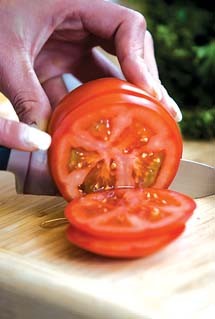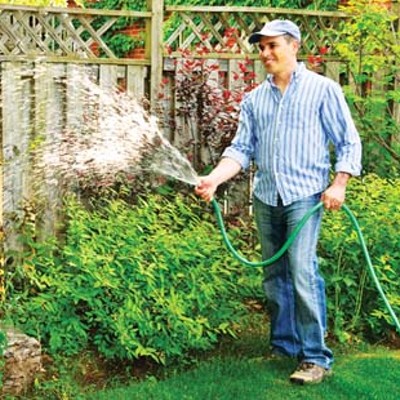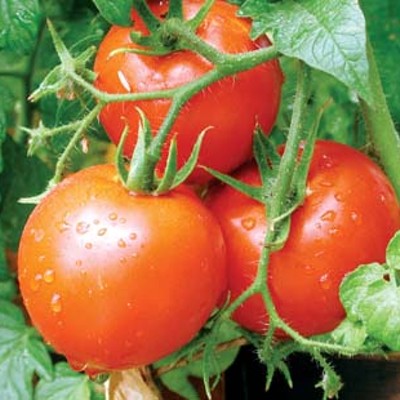One of the biggest joys of summer is eating a juicy
ripe tomato. Nothing beats the flavor of a garden fresh tomato on a
hamburger, on a bacon, lettuce, and tomato sandwich, or cherry tomatoes in
a salad.
Tomatoes are relatively easy to grow, but sometimes
it's a challenge to produce the picture-perfect fruit. They are more
than 40 tomato diseases. In addition, there are a number of
physiological (environmental) disorders that relate to growth conditions.
It's not uncommon to find a few problems with your crop during
a normal growing season.
Physiological problems can be caused by multiple factors. Some can be prevented with proper care, such as maintaining even soil moisture, mulching, providing proper nutrition, caging plants, rotating the location of the plants each year, and selecting resistant varieties.
Why does it take so long for tomatoes to ripen?
There are several factors that affect ripening, including amount of
sunlight, optimum temperatures, excess plant growth, lack of water, too
much water, or too much fertilizer. It takes a standard-size tomato 40 to
50 days after blossom set to reach maximum size. The larger the
fruit, the slower it will ripen. Therefore, late planting can cause
tomatoes to ripen later than expected.
If the plant has heavy fruit, it will take a lot of
energy from the plant and can delay the whole crop turning red. Tomatoes
need sunlight to ripen. Plants with excess plant growth can reduce
exposure of fruit to the sunlight and delay ripening. If this is the
case, remove some of the vines to expose fruits.
Temperature is crucial to tomato fruit ripening. Red tomato pigments, lycopene and carotene, are produced between 50 to 85 degrees Fahrenheit. These pigments are necessary for the ripening process. The optimum temperature range for ripening tomatoes is 68 to 77 degrees Fahrenheit. Extreme heat or cool temperatures will delay ripening. The longer temperatures stray from the optimum, the more stress to the fruit.
Blossom end rot is a sunken, dry, leathery, dark brown or black area on the bottom of the fruit. This can occur when wide fluctuations of soil moisture affect the plant's ability to take up calcium. Be sure to maintain an even soil moisture by mulching around plants and watering during dry periods. If calcium deficiency is suspected, have the soil tested.
Fruit cracking appears as concentric cracks around
the stem or cracks radiating out from the stem. Cracks occur when
there are wide fluctuations in temperature and moisture. For example
a dry period followed by too much water increases cracking. Decrease
the chances of this disorder occurring to fruit by maintaining uniform soil
moisture and growing crack-resistant varieties.
Zippering is a thin longitudinal scar that extends
from the stem end to the blossom end. The scar resembles a zipper.
This occurs when the blossom doesn't detach from the fruit
after pollination.
Yellow shoulders occur when the top of the fruit
fails to ripen completely. The area under the discoloration will be
corky. This is partly a genetic problem, therefore grow resistant
varieties. In addition maintain good foliage cover over fruits so
that they are shaded.
Sunscald is a yellow to white water-soaked area that forms on green tomatoes on the side of the fruit exposed to the sun. This is particularly a problem during hot, dry weather. Sunscald often occurs on plants that have lost their lower leaves due to other diseases. To prevent sunscald, maintain good foliage cover and cage your plants.
Blotchy ripening (or gray wall) gets its name because
the fruit ripens unevenly. Patches of the tomato remain green,
yellow-green or gray green while the rest of the tomato ripens. The
severity of this disorder is increased by low light conditions, high
nitrogen, low availability of nutrients, low potassium, or compacted soils.
To view photos of some of these disorders visit the University of Wisconsin Extension, "Tomato disorder: Physiological fruit problems," http://learningstore.uwex.edu/pdf/A3798.pdf .
The next time you pick or purchase a tomato think about all the conditions that were just right to produce the picture-perfect tomato.
Jennifer Fishburn is a horticulture educator with the University of Illinois Extension Sangamon-Menard Unit. Contact her at [email protected].




















